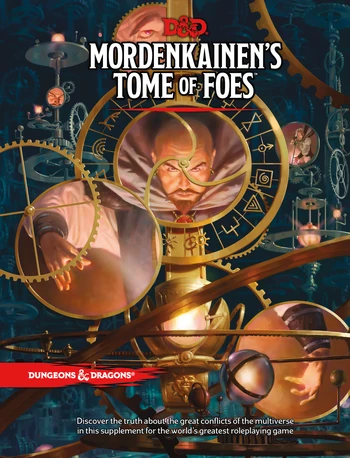
Again, not a whole ton for me as an introduction here. I spent the past week reading through a huge chunk of Mordenkainen's first half, but... I guess I just really am not super interested about the history of elven gods and anything involving the Gith? The fiend stuff are pretty nice, though, even if they did went a bit overboard in detailing every single archdevil and whatnot, it's still better to have these information for background in a D&D campaign rather than not.
Anyway, I've re-edited the first part of the Mordenkainen's Tome of Foes coverage a little bit because I've actually finally re-read the segments of the book detailing the elves, dwarves, Gith and stuff. I've also finally finished reading Volo's, and have edited some parts of my coverage on them. I really do like these sort of books, honestly, that just cover the culture and the racial identity of these huge parts of D&D lore, and I do find it interesting how they use this as an excuse to tie in a bunch of seemingly unrelated monsters together. That's pretty neat.
- Click here for the first part of Mordenkainen's, covering Allip to Eidolons.
- Click here for the next part of Mordenkainen's, covering the demons and demon lords.
- Click here for the index.



Eladrin
- 5.5E/5E: Medium Fey; Chaotic Neutral; CR 10 (Autumn), 10 (Spring), 10 (Summer), 10 (Winter)
Where elves are able to control their emotions and whatnot, Eladrin wear their emotions on their sleeves -- literally, too, because their physical shape and even powers change depending on their emotions. Some Eladrin move through the different emotional spectrum every other week, while others are happy to remain in the same seasonal shape for years. It's a very fun showcase of literal nature-attuned spirits, in the way that many fantasy elves are portrayed. The different sub-types of Eladrin in 5E also basically have different powers and emotions associated with seasons. Autumn Eladrin are all about goodwill, defusing conflict and like to heal, cure and alleviate suffering, which is... interesting? It's not something I associate with autumn. The others are a bit more obvious -- Spring Eladrin are all about joy and happiness and mischief; Summer is all angry and wrathful and ready to fight; Winter is sad, sorrowful and bitter. The artwork are pretty damn neat, and I absolutely love the pretty different variations for spring, summer, autumn and winter Eladrins. I think the summer Eladrin with his almost gold-like face and the beautiful golden leaves and the bent sword looks the coolest, but I also really do like the autumn Eladrin with her little hunting dress.'
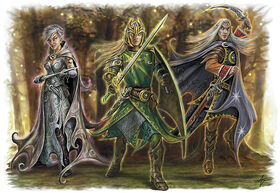 These Eladrin really feel like they will probably show up mostly as a playable race or NPC's or whatever, but since this is a monster bestiary book the D&D team are obligated to note potential avenues of conflict with adventurers, and like most fey, Eladrin basically just really loves beauty and sometimes they just want to abduct or steal really beautiful objects or people. These guys are fey, though, so they already operate on a pretty different morality compass than mortals -- any decent DM would be able to go off that without the bestiary having to shove down "hey these guys sometimes kidnap people all right?" Like, we've had a lot of evil baby-kidnapping fey already, the Eladrin seems pretty much tailor-made to basically be people who become antagonists thanks to misunderstandings and a different culture, y'know?
These Eladrin really feel like they will probably show up mostly as a playable race or NPC's or whatever, but since this is a monster bestiary book the D&D team are obligated to note potential avenues of conflict with adventurers, and like most fey, Eladrin basically just really loves beauty and sometimes they just want to abduct or steal really beautiful objects or people. These guys are fey, though, so they already operate on a pretty different morality compass than mortals -- any decent DM would be able to go off that without the bestiary having to shove down "hey these guys sometimes kidnap people all right?" Like, we've had a lot of evil baby-kidnapping fey already, the Eladrin seems pretty much tailor-made to basically be people who become antagonists thanks to misunderstandings and a different culture, y'know?

Elder Elemental: Leviathan
- 5.5E/5E: Gargantuan Elemental; Neutral; CR 20
The Elder Elemental for water is the Leviathan, a monster term that... I'm genuinely surprised to realize haven't had much mileage in D&D. The only official D&D Leviathan I've been able to find prior to 5E is a giant whale from 3.5E, a one-off monster that's just hanging out in a page of its many Monster Manuals. I guess it is kind of true that water monsters just aren't that popular? 5E's Leviathan, meanwhile, is a gigantic sea serpent/dragon thing made entirely out of water currents, and that sure is a cool picture! Mordenkainen's describes the Leviathan as less of a beast and more of a force of nature, noting that it's "a towering wall of water that drags ships down and washes away coastal settlements". It's not a giant sea serpent, it's just water itself that sometimes takes on the form of a sea serpent. Not the most original monster concept, but a pretty cool one.
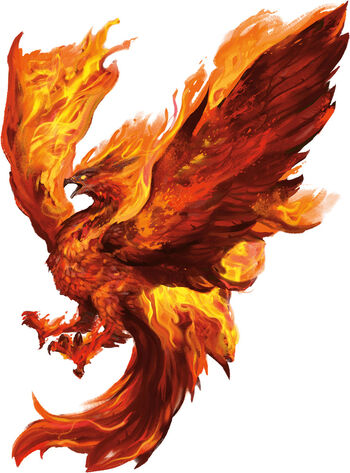
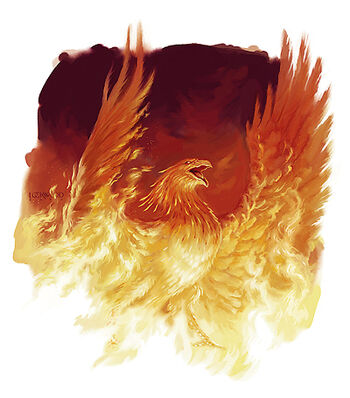
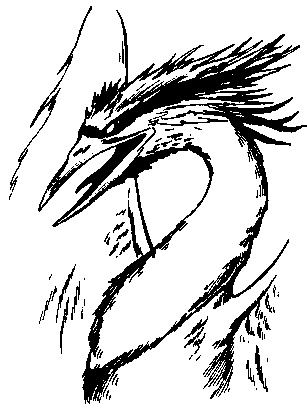
Elder Elemental: Phoenix
- 5.5E/5E: Gargantuan Elemental; Neutral; CR 16
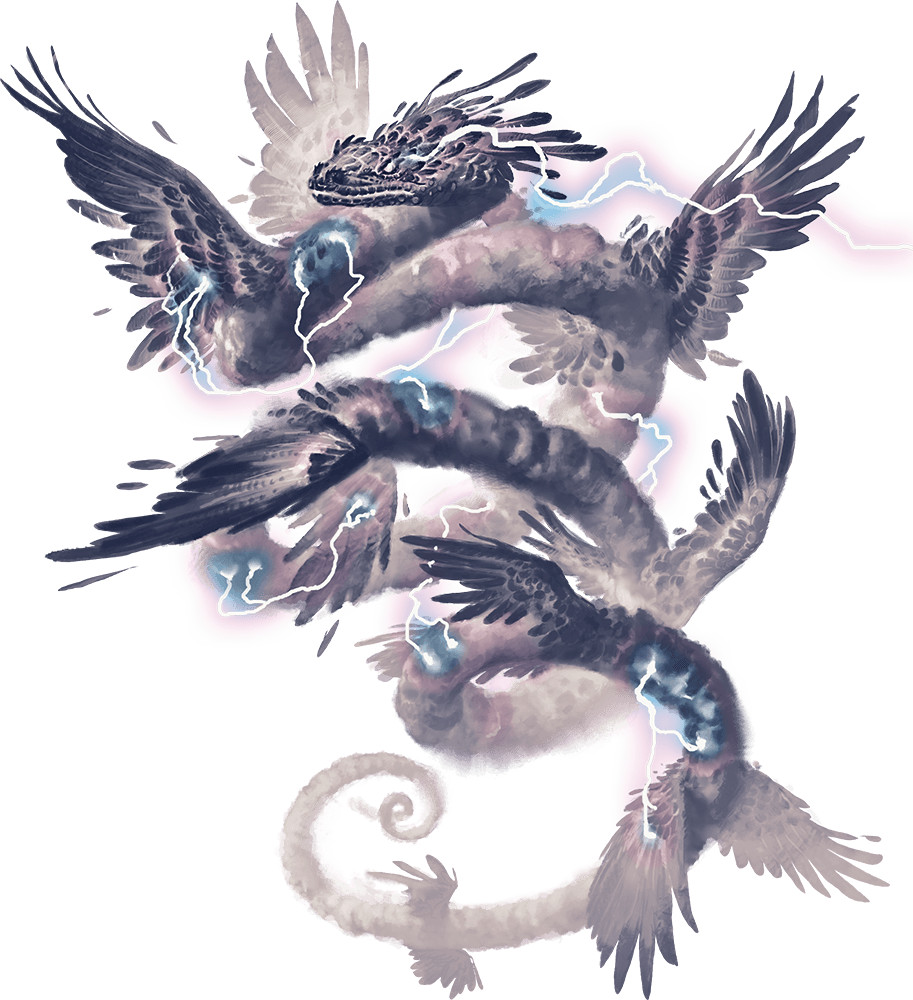
Elder Elemental: Elder Tempest
- 5.5E/5E: Gargantuan Elemental; Neutral; CR 23
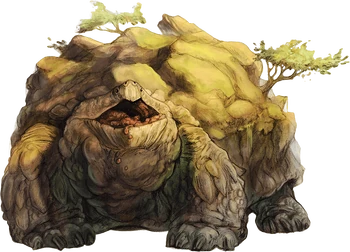
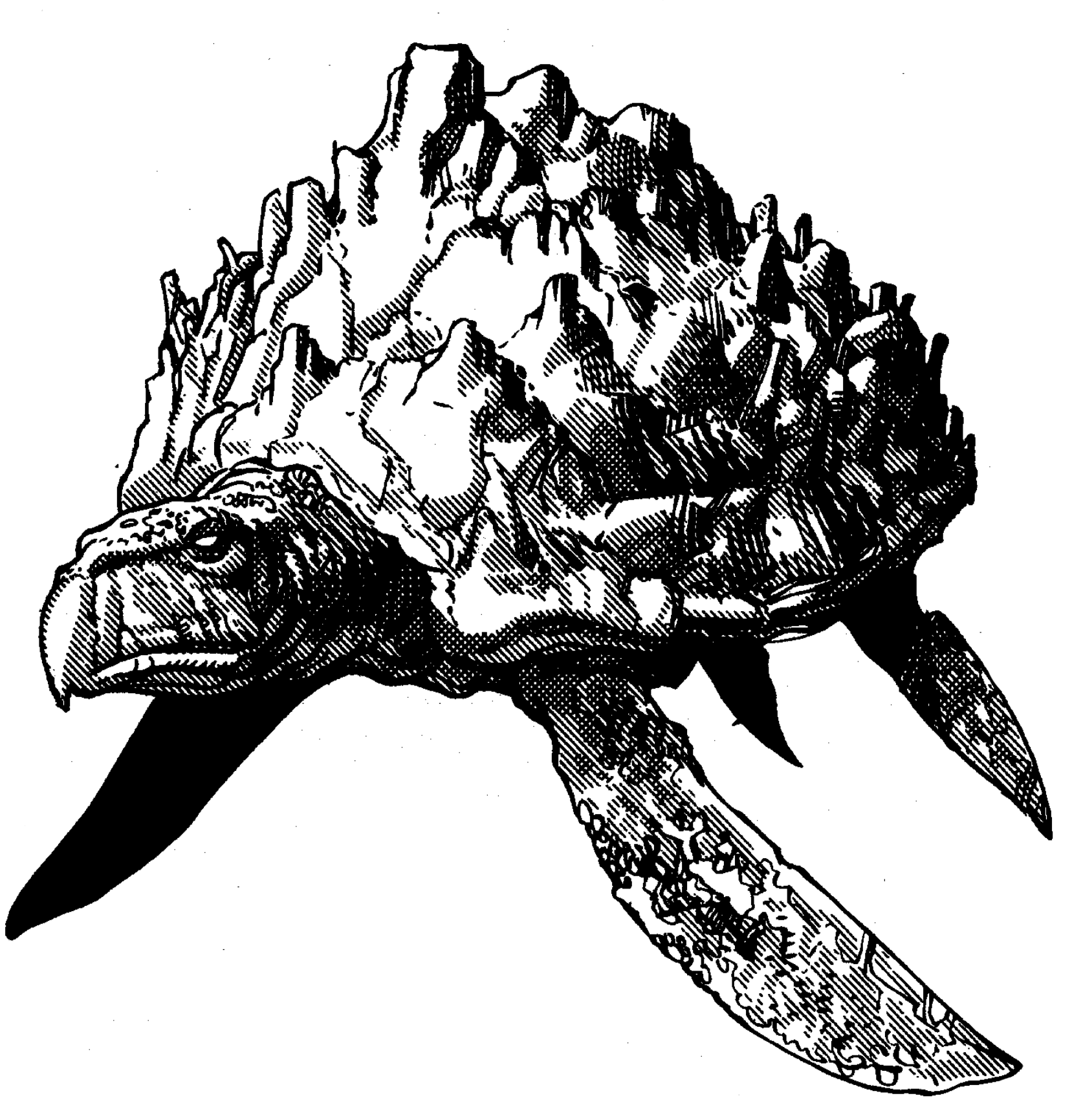
Elder Elemental: Zaratan
- 5.5E/5E: Gargantuan Elemental; Neutral; CR 22


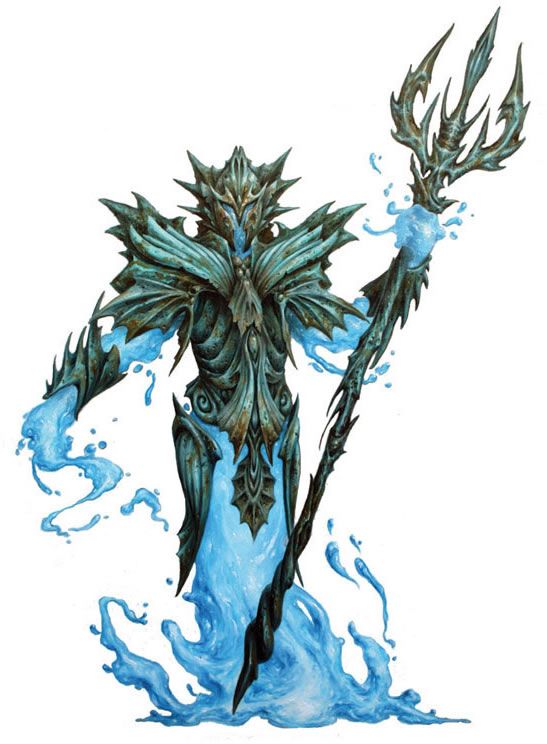
Elemental Myrmidons
- 5.5E/5E: Medium Elemental; Neutral; CR 7 (Air Myrmidon), 7 (Earth Myrmidon), 7 (Fire Myrmidon), 7 (Water Myrmidon)
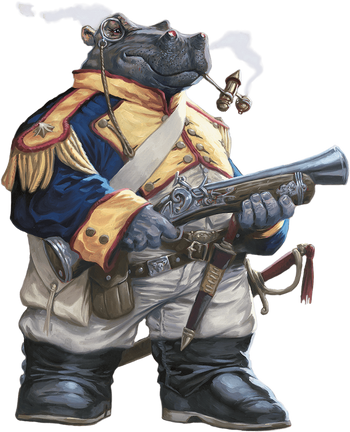

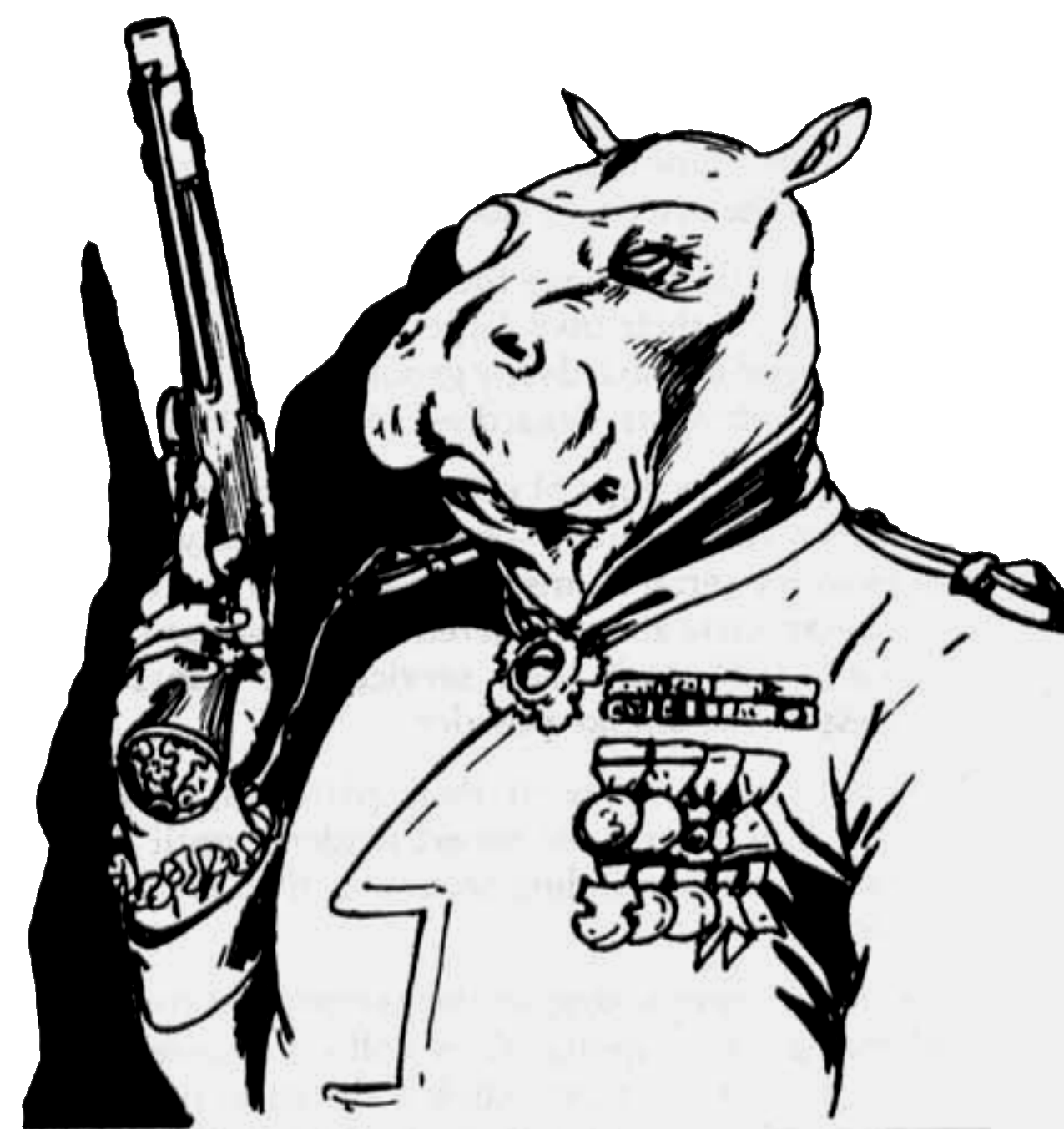
Giff
- 5.5E/5E: Medium Humanoid; Lawful Neutral; CR 3
All Giffs respect the military rank and see it as absolute. They work as interstellar mercenaries, but they insist on only serving in units composed entirely of other Giff, and will only sign contracts with a small print that says that it can sit out of any battle that pits it against other Giff. So serious, for a bunch of hippo people. Also, since they come from space, they have access to the highly amazing, advanced technology of... guns and the weaponizing of gunpowder. Which, depending on your setting, may or may not have existed before, and would be an absolute game-changer. Apparently they prefer payment in gunpower instead of gold, too, which... yeah, that makes sense as anything about the Giff. Anyway, I love these things. They look just so out of place with their Napoleonic outfits and chunky rifles, and I absolutely love the fact that the 5E artwork tries to make a goddamn hippo-person so posh with a monocle and the most fancy of pipes.
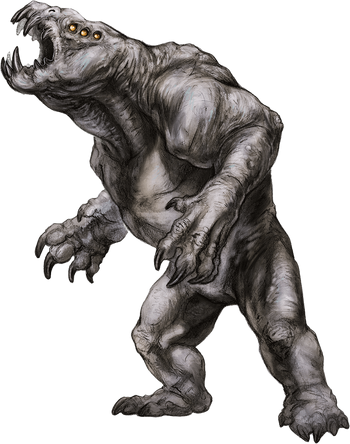
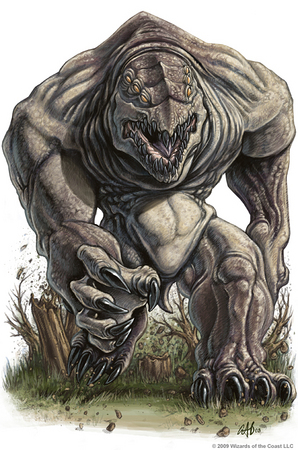
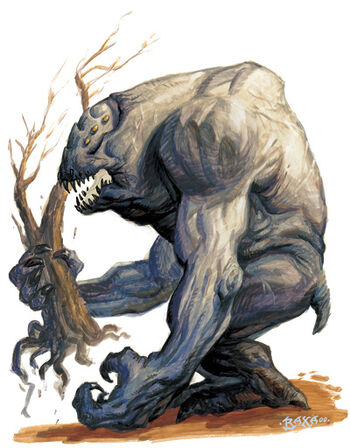
Gray Render
- 5.5E/5E: Large Monstrosity; Chaotic Neutral; CR 12
Interestingly, Gray Renders reproduce not by giving birth or laying eggs, but by budding, creating little nodules that break off from their body that turn into more young Gray Renders, and they never take care of their young -- meaning that young Gray Renders have an instinctual impulse to go look for non-Gray-Render intelligent creatures to bond with, described lovingly as the Render singing and scratching the ground to ask permission to basically be your huge lumbering puppy forever and ever. Except, well, taking care of a Gray Render is a huge responsibility and like most large dogs, Gray Renders don't have a good gauge of their strength or what's socially acceptable. They'll never harm their master, but everything else is fair game. It's just that instead of your dog scratching up your sofa, your pet Gray Render might accidentally murder everyone in a tavern because someone bumped into you. And also, like real dogs, sometimes they get jealous at you showing affection to anyone else and might attack like a business client or whatever. Anyway, this is a gloriously adorable giant rock-beast monster and I love its flavour so much even if the design is disappointingly boring.
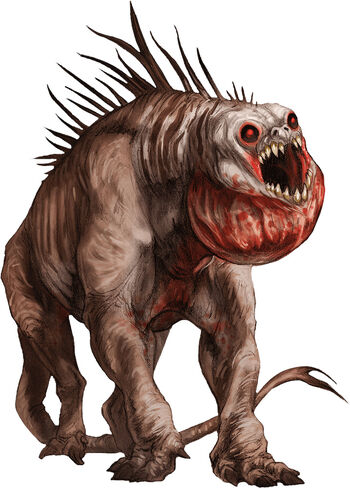
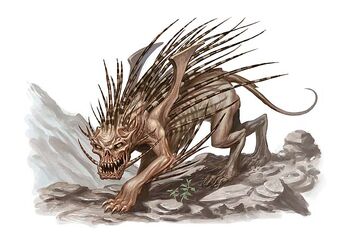
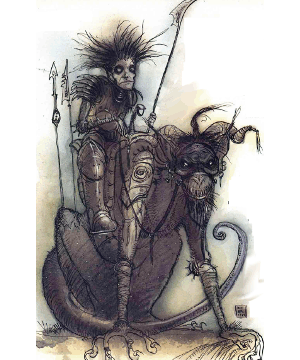
Howler
- 5.5E/5E: Large Fiend; Chaotic Evil; CR 8
Anyway, I haven't even mentioned what a Howler is, huh? They arrive from the plane of madness, Pandemonium, and sometimes hang out in the Lower Planes like hell, and they're basically hideous beasts that unleash massive wailing yowls that strike confusion and fear into the hearts of the weak-willed, and can drive people insane. There really isn't much to them, they're just pack hunters that also have a fear/insanity-causing howl, and they tended to be captured and enslaved by fiends and other nasty beings, but I really do like them for that reason, and I enjoy the description in various monster manuals noting how they can only stare in shock and stumble aimlessly around the battlefield after succumbing to a Howler's howl, leaving them easy prey for the Howlers and/or their handlers. There's really not much more for me to say here, it's just a critter I find pretty dang cool.
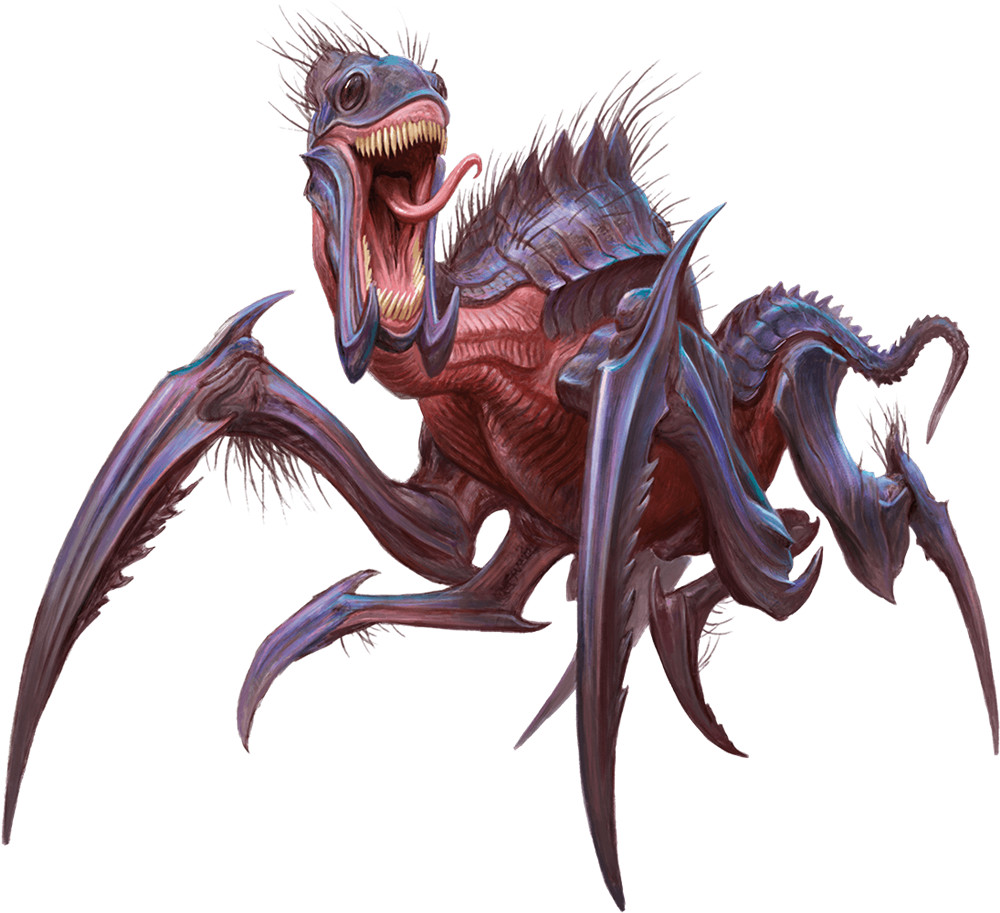
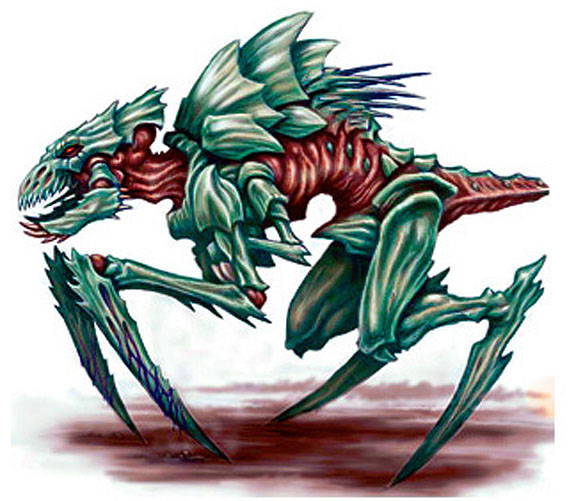
Kruthik
- 5.5E/5E: Small Monstrosity; Unaligned; CR 1/8 (Young Kruthik)
- 5.5E/5E: Medium Monstrosity; Unaligned; CR 2 (Kruthik)
- 5.5E/5E: Large Monstrosity; Unaligned; CR 5 (Kruthik Hive Lord)
You can just imagine one of these thing just scuttling around with its massive pointed feet, clattering all over the place as they communicate with their chattering hisses... and that's why they are very dangerous. Like real-life ants and termites, a single Kruthik might not amount to much, but give them a chance and they will summon the wrath of the entire hive to deal with the intruders, and the more Kruthiks are around, the more bold each individual one becomes. Also like real-life communal insects, the scent of enough dead Kruthiks might actually repel the entire hive, which is a neat way to 'defeat' an entire hive without having to fight the hundreds of Kruthiks that live there. Oh, and Kruthik hives also play host to other creatures, like oozes and undead, which they tolerate as guards in a neat way of symbiosis. Mordenkainen's also briefly describes the Kruthik life-cycle, going from egg to the juvenile young Kruthik, to an adult Kruthik... it's not necessary, but I appreciate this so much. The Hive Lord is, of course, the equivalent to the 'queen' of the colony, but even if you slay a Hive Lord, the rest of the Kruthik hive will just retreat, find a new lair, and then the largest Kruthik in the hive will metamorphose into a new Hive Lord. So I guess you do have to exterminate them to the last, then, to truly end the threat of the Kruthik infestation?
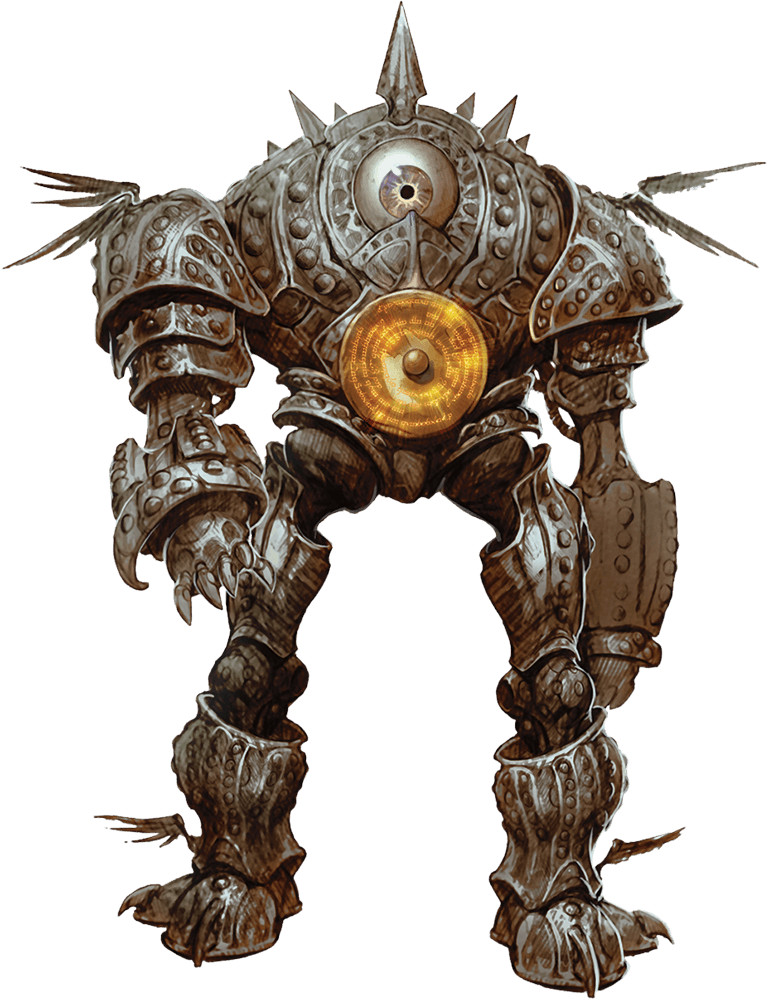


Marut
- 5.5E/5E: Large Construct; Lawful Neutral; CR 25
I am not 100% sure about their lore in previous editions, but in 5E, the Inevitables are also part of the huge Mordron society, created by their god-creator Primus to bring order to the deals between planar folks, and they're basically the less-evil versions of Yugoloths. The Maruts hang out in the Hall of Concordance, and any two parties who agree to mutual terms can pay another Inveitable, a Kolyarut (center of the 3E artwork), to chisel a contract onto a sheet of gold, which is placed onto the disc-player chest of a Marut, and until the contract is fulfilled the Marut will enforce its terms and beat the shit out of any party who tries to break the terms of the contract. The Maruts are noted to be cold and unfeeling, caring nothing for the spirit of the agreement, only the letter, and will enforce what is written and not what is meant to be understood. It's certainly the basis of a very interesting encounter, and one that Mordenkainen's helpfully notes is great to be used in a storyline involving yugoloths and deals.
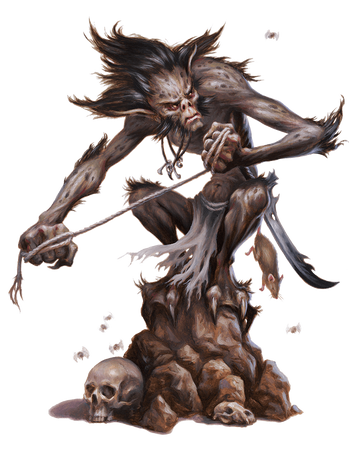
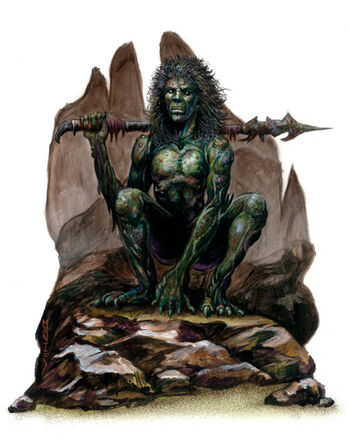
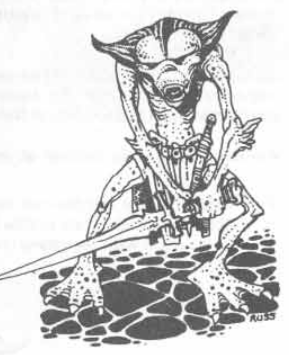
Meazel
- 5.5E/5E: Medium Humanoid; Neutral Evil; CR 1
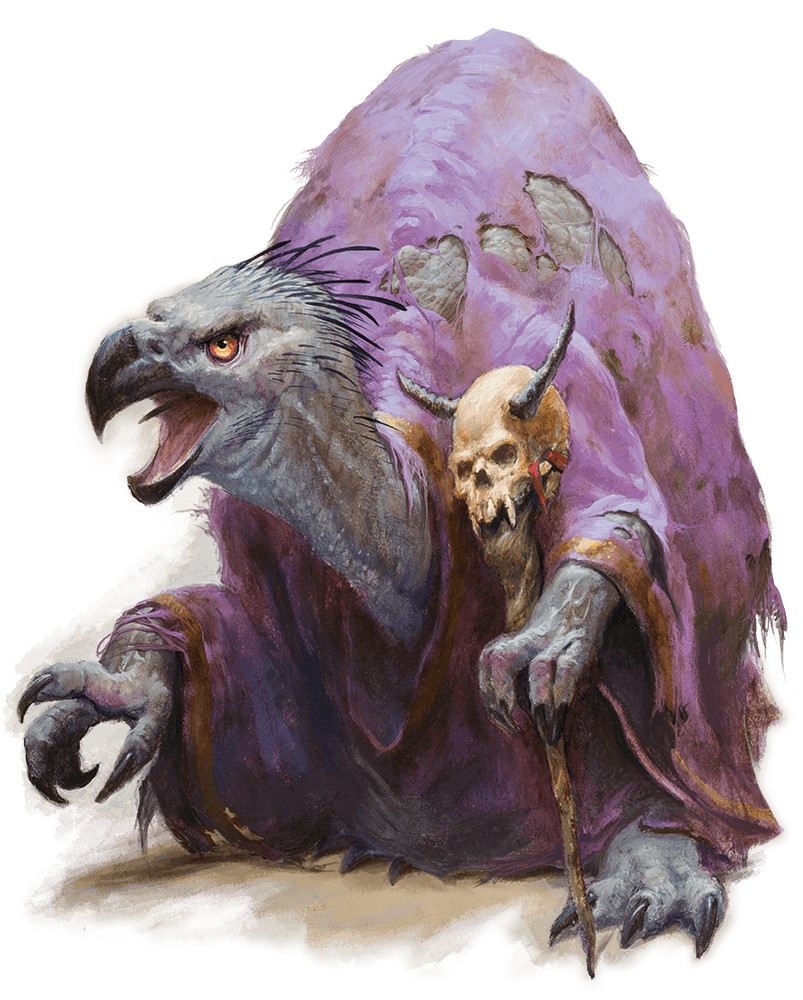
Nagpa
- 5.5E/5E: Medium Humanoid; Neutral Evil; CR 17
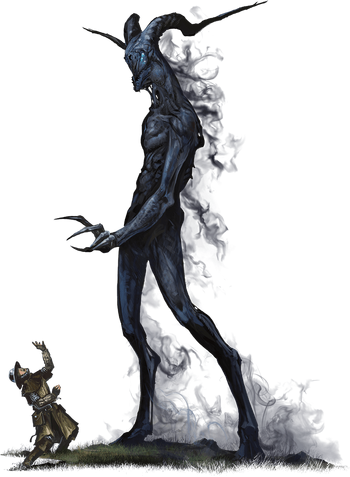
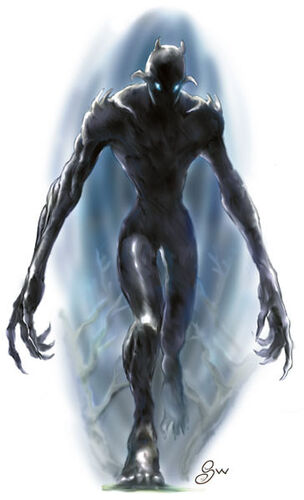
Nightwalker
- 5.5E/5E: Huge Undead; Chaotic Evil; CR 20
3E's original introduction of the "Nightshade" creatures features a lot of other delicious variants, but we're keeping it simple with just one big, lanky, scary humanoid shadow giant for now.


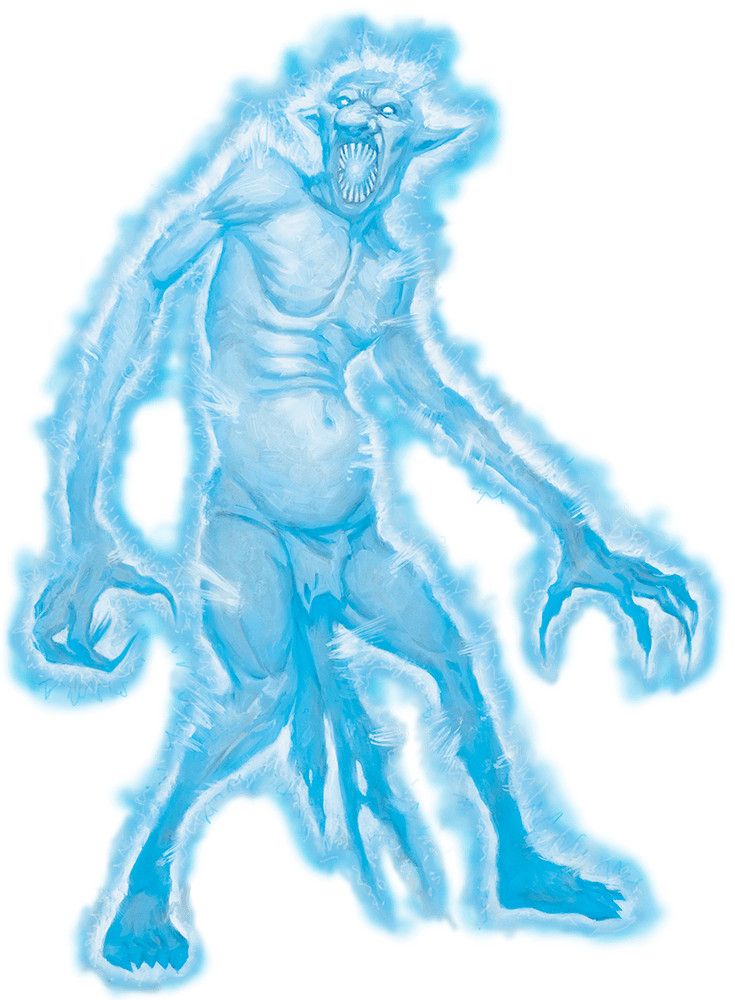

Trolls!
- 5.5E/5E: Huge Giant; Chaotic Evil; CR 13 (Dire Troll)
- 5.5E/5E: Large Giant; Chaotic Evil; CR 9 (Rot Troll), 11 (Spirit Troll), 7 (Venom Troll)
Right, here's a little bonus. I completely forgot to talk about the trolls last time when I covered 'hey, we talked about these races before, but Tome of Foes gives us extra variants". Unlike the Drow or Duergar or Ogres, though, the trolls actually do have a lot of physical differences that give me a fair bit more to talk about, which is why I'm actually glad I missed them since now I can talk about them a bit more. I do appreciate that it's the troll that has a relatively large amount of variation, considering how varied the definition of 'troll' even is in human culture. Going from left to right...
The Dire Troll isn't just a bigger, scarier troll like a Dire Wolf or a Dire Bear or a Dire Porcupine, but rather a troll that has engaged in cannibalism, and apparently when trolls eat the flesh of another troll, they grow so much but they also want 'more troll flesh' to continue their growth. And this apparently translates into 'slap the flesh of the trolls I kill into my body', which is why the hideous Dire Troll have grafted extra arms and heads where they don't belong, and the artist does a pretty great job showcasing this. Those extra random fingers sprouting out of the lower arm of the Dire Troll's left arm, that little face and extra mouths growing from his belly and pectorals... the first time I saw this and read the first part of the write-up, I thought it's just a troll whose regenerative cells or whatever went haywire after cannibalism, but turns out that, no, it's a bit more gruesome than that.
The Rot Troll, in contrast, looks almost normal. I mean, as a normal troll could be. Sure, it's half-decayed thanks to the fact that the Rot Troll is infused with necrotic energy as it is regenerating from a wound, but it's not until you read the description that you realize that thanks to the infusion of necrotic energy, the Rot Troll's regeneration and the infused necrotic energy causes his body to decay and heal up in an unending cycle. The Spirit Troll... is also not the most exciting, basically what happens when you blast a troll with psychic energy when it's regenerating, turning it into basically a ghostly psychic troll that attacks the enemy's mind. But the troll's too dumb to realize that!
Venom Trolls, meanwhile, are trolls that are mutated by a large infusion of poison, and while the description isn't all that exciting -- it's just a troll whose body now produces venom and has venom dripping out of every orifice in combat -- the artwork really sells how wretched and terrifying this creature can be. Sometimes it's the description, sometimes it's the artwork, yeah?
The Dire Troll isn't just a bigger, scarier troll like a Dire Wolf or a Dire Bear or a Dire Porcupine, but rather a troll that has engaged in cannibalism, and apparently when trolls eat the flesh of another troll, they grow so much but they also want 'more troll flesh' to continue their growth. And this apparently translates into 'slap the flesh of the trolls I kill into my body', which is why the hideous Dire Troll have grafted extra arms and heads where they don't belong, and the artist does a pretty great job showcasing this. Those extra random fingers sprouting out of the lower arm of the Dire Troll's left arm, that little face and extra mouths growing from his belly and pectorals... the first time I saw this and read the first part of the write-up, I thought it's just a troll whose regenerative cells or whatever went haywire after cannibalism, but turns out that, no, it's a bit more gruesome than that.
The Rot Troll, in contrast, looks almost normal. I mean, as a normal troll could be. Sure, it's half-decayed thanks to the fact that the Rot Troll is infused with necrotic energy as it is regenerating from a wound, but it's not until you read the description that you realize that thanks to the infusion of necrotic energy, the Rot Troll's regeneration and the infused necrotic energy causes his body to decay and heal up in an unending cycle. The Spirit Troll... is also not the most exciting, basically what happens when you blast a troll with psychic energy when it's regenerating, turning it into basically a ghostly psychic troll that attacks the enemy's mind. But the troll's too dumb to realize that!
Venom Trolls, meanwhile, are trolls that are mutated by a large infusion of poison, and while the description isn't all that exciting -- it's just a troll whose body now produces venom and has venom dripping out of every orifice in combat -- the artwork really sells how wretched and terrifying this creature can be. Sometimes it's the description, sometimes it's the artwork, yeah?
The stats for the creatures we covered here.
- Autumn Eladrin: Medium fey - elf; chaotic neutral; CR 10
- Spring Eladrin: Medium fey - elf; chaotic neutral; CR 10
- Summer Eladrin: Medium fey - elf; chaotic neutral; CR 10
- Winter Eladrin: Medium fey - elf; chaotic neutral; CR 10
- Leviathan: Gargantuan elemental; neutral; CR 20
- Phoenix: Gargantuan elemental; neutral; CR 16
- Elder Tempest: Gargantuan elemental; neutral; CR 23
- Zaratan: Gargantuan elemental; neutral; CR 22
- Air Elemental Myrmidon: Medium elemental; neutral; CR 7
- Earth Elemental Myrmidon: Medium elemental; neutral; CR 7
- Fire Elemental Myrmidon: Medium elemental; neutral; CR 7
- Water Elemental Myrmidon: Medium elemental; neutral; CR 7
- Giff: Medium humanoid; lawful neutral; CR 3
- Gray Render: Large monstrosity; chaotic neutral; CR 12
- Howler: Large fiend; chaotic evil; CR 8
- Young Kruthik: Small monstrosity; unaligned; CR 1/8
- Adult Kruthik: Medium monstrosity; unaligned; CR 2
- Kruthik Hive Lord: Large monstrosity; unaligned; CR 5
- Marut: Large construct - inevitable; lawful neutral; CR 25
- Meazel: Medium humanoid - meazel; neutral evil; CR 1
- Nagpa: Medium humanoid - nagpa; neutral evil; CR 17
- Nightwalker: Huge undead; chaotic evil; CR 20
- Dire Troll: Huge giant; chaotic evil; CR 13
- Rot Troll: Large giant; chaotic evil; CR 9
- Spirit Troll: Large giant; chaotic evil; CR 11
- Venom Troll: Large giant; chaotic evil; CR 7
No comments:
Post a Comment